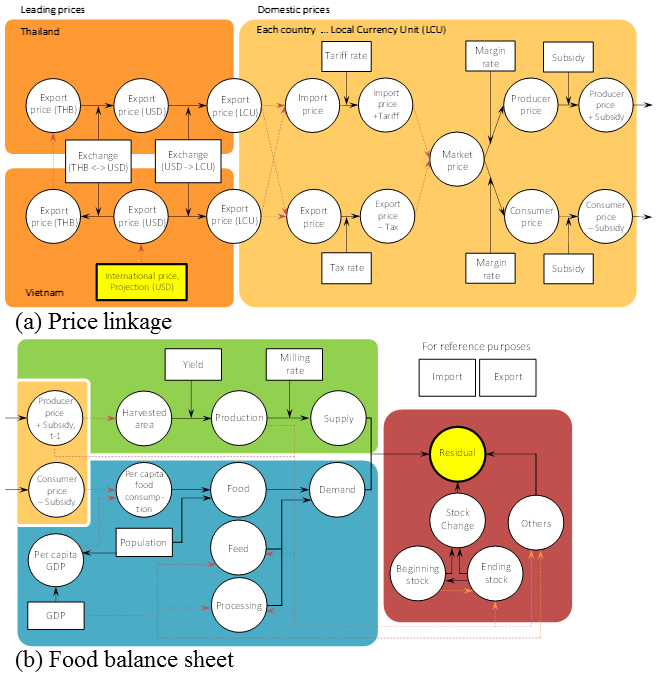Dissemination of a food commodity supply and demand model for ASEAN countries through an instruction manual
Description
Future trends in food supply and demand have been gaining attention among ASEAN countries where agricultural trade liberalization is expected because of the establishment of the ASEAN Economic Community in 2015. In line with this, JIRCAS built an econometric model, i.e., a middle-term non-equilibrium supply and demand model, for making future projections related to agro-food products, and an instruction manual was subsequently published to facilitate dissemination. The know-how about the model had already been transferred to government officers in ASEAN countries through collaboration with the ASEAN Food Security Information System (AFSIS). The manual would be useful to officers, researchers, and students who are interested in understanding, building, and utilizing the model.
The manual contains the conceptual diagram (Fig. 1), the model structure expressed in an Excel worksheet (Fig. 2), and the projection results of the model (Fig. 3) as well as examples of scenario analyses. The non-equilibrium model in this manual does not presume equilibrium of food supply and demand in the domestic market, and would be the foundation for understanding more complicated models like the partial-equilibrium model often used by international organizations such as the Organization for Economic Cooperation and Development, Food and Agriculture Organization (OECD-FAO).
The manual shows how to use the model for policy evaluation and for comparative statics or welfare analysis. It also explained the basic concepts of econometrics required to develop the model including regression analysis, the adjusted coefficient of determination, and the standard error. In addition, for AFSIS project participants, the methods used to run the programs in developing and utilizing the model are further described.
The manual was published and disseminated to government staffs of ASEAN member states who participated in the project. It can also be downloaded from the AFSIS website (http://www.aptfsis.org/). It must be noted, however, that readers and users need to scrutinize the data and parameters in the manual, as these were collected and estimated by project participants. To produce better information from the analysis, provincial-level or more site-specific data should be used to build the model rather than the country-level model referenced in the manual. Furthermore, the model can be extended to partial-equilibrium models, where the effects of supply-demand balance on food prices are highlighted.
Figure, table
-
Fig. 1. Conceptual diagram of the model (USD: US dollar, THB: Thai baht, LCU: Local currency unit)
-
Fig. 2. Sample spreadsheet data and equations for the model
-
Fig. 3. Estimated surplus in rice supply (2012-2019) (1000t)
- Affiliation
-
Japan International Research Center for Agricultural Sciences Social Sciences Division
- Research project
- Program name
- Term of research
-
FY2016(FY2016~FY2020)
- Responsible researcher
-
Kusano Eiichi ( Social Sciences Division )
Shiratori Sakiko ( Research Strategy Office )
KAKEN Researcher No.: 60746486Furuya Jun ( Social Sciences Division )
MIERUKA ID: 001740 - ほか
- Japanese PDF
-
A4 253.67 KB
A3 255.6 KB
- English PDF
-
A4 571.51 KB
A3 550.45 KB
- Poster PDF
-
Poster 377.71 KB



